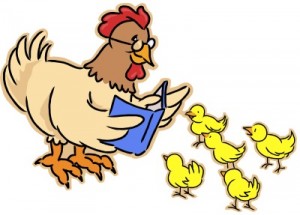 In a recent interview with CNN, author-illustrator Mo Willems said something that really resonated with me: “Always think of your audience, but never think for your audience. What that means is to leave it open to interpretation.”
In a recent interview with CNN, author-illustrator Mo Willems said something that really resonated with me: “Always think of your audience, but never think for your audience. What that means is to leave it open to interpretation.”
I really like that. We should always keep our audience in mind, especially for picture books, but we shouldn’t think for them. We should allow them to bring something to the book–their own experiences, their likes, dislikes, and imagination.
We should offer questions and problems that stem from their daily lives–sibling rivalry, starting school, jealousy, possessiveness, joy in the little things–but not necessarily provide direct answers. A story can have a resolution that is satisfying without banging the audience over the head with “this is the only way to solve this particular problem” or–shudder–offering some kind of overt lesson (as opposed to a universal theme that rises organically from the story).
Most of the editors at the larger publishing houses have indicated that the audience for their picture books is younger than it used to be*: two to five years old. For us that means getting into the heads of small humans and seeing what they care about, what makes them impatient, angry, and happy and providing stories that not only entertain, but offer a door to something more–something children can claim as their own.
*Note that this is the larger publishers. Many mid-sized and smaller publishers have a broader age range and longer word counts.



Hi Denise, As a former librarian and teacher, I wholeheartedly disagree with “most editors at larger publishing houses” on what the audience for picture book is. In my elementary classroom and school library, I have found picture books to be the “go to books” for all grade and age levels. If we as authors fall into this trap and write only for the 2-5 age span, we are missing out on readers above and beyond those ages. Why is it that the classic picture books have endured for generations? When I was a bookseller, why did parents and grandparents always ask for beautiful hard cover picture books as gifts for their children and grandchildren? Sometimes children want a simple story with beautiful illustrations. They don’t always want us to “get into the heads of small humans”. Let them escape into our words and pictures without worry about what makes them angry, happy or impatient. Don’t we know this already? And didn’t Beatrix Potter, AA Milne, and Mother Goose know this? We can overkill the themes that you mention above and sometimes children get tired of hearing and reading about it and most of all just want to read for pleasure’s sake. Have we forgotten that? I hope not.
Thank you SO much for your reasoned and impassioned comment. I have heard this from several teachers and librarians and I wish it would reach consumers and the larger publishers…sigh. The “big” publishers are seeing trade book consumers wanting shorter texts (this is the general population, not schools and libraries). I’ve heard that the reason for this is that many parents are pushing their kids to read at younger and younger ages and are using picture books to help them read. Once they learn to read at the 2-5 age range, they want to read “older” books and consider picture books for “babies.” I was dismayed and discouraged when I heard this. This was never the intention of the picture book, which to me is meant as a beautiful, fun shared experience between reader and listener(s). I, myself, have watched parents and children pass over picture books at the bookstore because they have “too many words,” something that saddens and frustrates me.
As for the classics, they have endured because there are adults like you and me sharing them with children which keeps them alive and in print. Most classics would not get published if they were submitted today, which makes it all the more important that we continue to get stories of all lengths and topics into the hands of kids. Passing on the stories we love continues to be a time-honored tradition, one that needs to endure.
You’re right that sometimes children want a simple story with beautiful illustrations. But they also like to laugh and smile and read stories that relate to their experiences. There is room for all kinds of stories, thank goodness. But if writers want to publish a picture book with one of the big 5 publishers, they will have to think short. That’s the reality for now anyway. If they are willing to expand their search to medium-sized and smaller publishers, they can find wonderful homes for books like you describe (hence my asterisked note). And I’m hoping bigger publishers will start to see the innovative and varied ways picture books are being used in classrooms for ALL ages as you’ve indicated, not just the youngest, and that parents will realize that longer texts and broader themes enrich all of our lives and deserve a place in the home library, not just the school and public libraries.
If children are getting tired of hearing and reading about certain themes, my guess is the writer is being didactic, hitting them over the head with some lesson or message. Only celebrities (or educational/niche writers) get to write that way and have it published! The rest of us want our themes to weave organically through an enjoyable story. Story always comes first.
I am grateful that there are teachers and librarians like you (former and current) who get these other books into the hands of readers and extend their life beyond the very young. The richness and enduring themes in these books are treasures! Thank you so much.